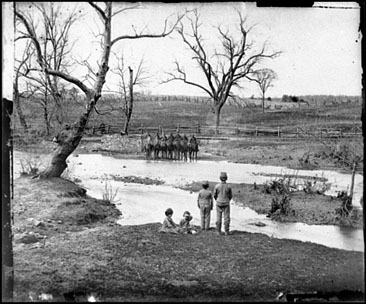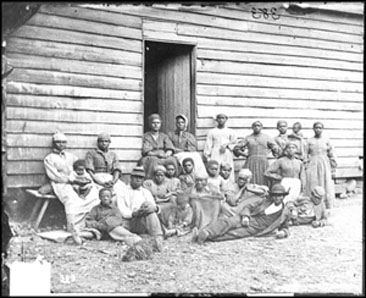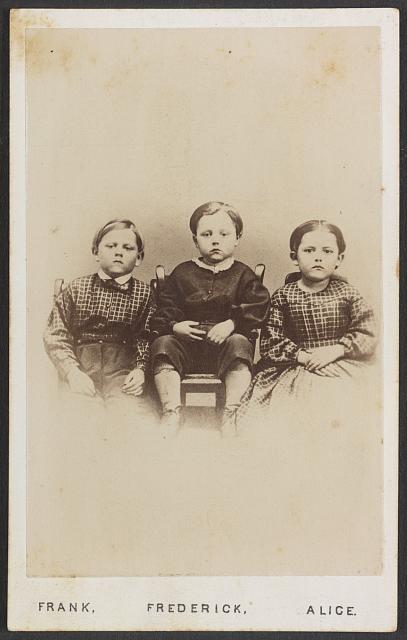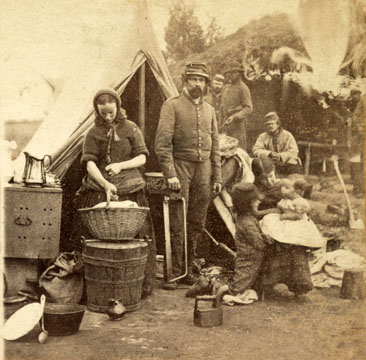Soldiers That Were Helping the Family During the Civil War
Childhood in the Civil War
By Madison Cline, North Carolina State Academy, 2013
No ane was untouched by the Ceremonious War, particularly in the South. With casualties and a significant population of men away at war, tremendous hardships were created for the women and children left on the abode front. Children of all races and circumstances endured a vast assortment of experiences during the Civil War.
 Children shared an excitement for the state of war, with enthusiasm and involvement in the political and armed forces affairs going on in the country. Boys, both black and white, showed excitement during armed services festivities and drills by running alongside militia teams as they paraded through the streets and fields. They created their own militia play and incorporated their ain political views into their war play. The war brought a natural curiosity to the children in the South, where some watched the action from the sidelines. In The Children's Civil War, James Marten tells the story of a mother whose 2 oldest sons begged her to let them to investigate a boxing virtually their abode. Later on that evening she securely regretted her conclusion to let them go. When the boys returned home, they were not the aforementioned boys that left before that solar day. In Topsy-Turvy: How the Civil State of war Turned the World Upside Downwards for Southern Children, Anya Jabour describes that same enthusiasm children had for witnessing the war upwardly close, depicted in a wartime photograph of several children getting as close as possible to run into the soldiers at Sudley Ford, Virginia every bit they were on their way to what would become the Battle of Bull Run. The photograph comes from the collections of the Library of Congress, and in the prototype the boys wear military fashion hats.
Children shared an excitement for the state of war, with enthusiasm and involvement in the political and armed forces affairs going on in the country. Boys, both black and white, showed excitement during armed services festivities and drills by running alongside militia teams as they paraded through the streets and fields. They created their own militia play and incorporated their ain political views into their war play. The war brought a natural curiosity to the children in the South, where some watched the action from the sidelines. In The Children's Civil War, James Marten tells the story of a mother whose 2 oldest sons begged her to let them to investigate a boxing virtually their abode. Later on that evening she securely regretted her conclusion to let them go. When the boys returned home, they were not the aforementioned boys that left before that solar day. In Topsy-Turvy: How the Civil State of war Turned the World Upside Downwards for Southern Children, Anya Jabour describes that same enthusiasm children had for witnessing the war upwardly close, depicted in a wartime photograph of several children getting as close as possible to run into the soldiers at Sudley Ford, Virginia every bit they were on their way to what would become the Battle of Bull Run. The photograph comes from the collections of the Library of Congress, and in the prototype the boys wear military fashion hats.
Children of the Civil State of war, both black and white, stepped up to contribute to the state of war attempt and to make full the void of absent fathers and brothers on the abode front. This proved especially true for many children in North Carolina. Throughout the S, like in North Carolina, older boys and girls worked in armament factories as well equally in government offices. Children scraped lint to make bandages for wounded soldiers, and younger children gathered supplies and food for local soldiers. Co-ordinate to Marten's research on this topic, a few former slave children, including Booker T. Washington, felt little touch when the state of war started because they were already laden with responsibilities and hard work. For other slave children, the state of war did bring an even heavier workload. In some cases, young slaves were forced into fields at a much younger historic period. Marten added that it was not unusual for a teenage slave boy to accompany his master into war or for a teenage slave girl to run up for soldiers and nurse the wounded rebels.

As the war progressed and conditions worsened, both blackness and white children in the South faced greater and greater hardships and destruction. At that place was a shortage of food, a lack of clothing, much disease, and homelessness. White children and their families fled their homes and land to escape Union soldiers, while black children and their families fled to the Union soldiers for protection. Families were split autonomously and displaced. Black children felt disruption and chaos every bit well. Many one-time slaves fled plantations to seek refuge at "contraband" camps. These camps were an important role of Northward Carolina's history in the Ceremonious War. Refugees were able to earn wages, piece of work for food and clothing, go an education, and worship. There were six camps established by the Spousal relationship in Northward Carolina (at Hatteras, Plymouth, Washington, Beaufort, New Bern and Roanoke Island), and eventually all six camps came under Confederate attack.

Southern children suffered not only physical hardships but emotional hardships. Fear was a dominant emotion among both black and white children with the fearfulness of home invasions by the Yankees, physical violence and death, and separation of family unit. Jabour recounts children's fears in Topsy-Turvy with their stories, including some N Carolina children. George Robertson, an eight-year-erstwhile white boy from Asheville, Northward Carolina, feared the Wedlock soldiers. He wrote how intimidating and loud the Union soldiers were when they took over his family's habitation and how they thumped and clanged and banged all over the firm equally if to intentionally create chaos, withal they hurt null. In fact, they posted a guard at young George's home to protect his family from further invasion. George reminisced how fond his family unit grew of this young Yankee soldier and that he actually addressed George's female parent as Mother and helped out with work around the firm. Children in the s had a real fearfulness of violence with the fear of beingness shot and killed as a Matrimony sympathizer. Enslaved children feared the reality of existence torn from their families.
The terminate of the Civil War brought different meanings and emotions for white and blackness children. The Ceremonious State of war officially concluded when General Johnston surrendered to General Sherman at the Bennett Place subcontract nearly Durham Station, N Carolina, in April of 1865. Once the news of Confederate defeat and the emancipation of slaves began to arrive, black children responded to the news with jubilation and hope for the time to come while white children were more despondent and dreaded the time to come. White children saw a part reversal and now perceived themselves as enslaved and oppressed past the Matrimony troops and Northern politicians who forced the cease to slavery on them. Black children perceived the Union troops as their liberators and trusted the politicians to protect them and their newfound liberty.
 Although historians do agree that the Civil War was hard on everyone, specially Southern children, the greatest affect, yet, was actually to the enslaved African American child. Post-obit the state of war, Reconstruction brought new challenges and hardships to African American children, every bit their families were suddenly given a option between continuing to work for former masters or being uprooted with the strong possibility of being subjected to crushing poverty. Continued racism meant that black children in the South encountered white hate groups, segregation, and racial violence in the aftermath of the war.
Although historians do agree that the Civil War was hard on everyone, specially Southern children, the greatest affect, yet, was actually to the enslaved African American child. Post-obit the state of war, Reconstruction brought new challenges and hardships to African American children, every bit their families were suddenly given a option between continuing to work for former masters or being uprooted with the strong possibility of being subjected to crushing poverty. Continued racism meant that black children in the South encountered white hate groups, segregation, and racial violence in the aftermath of the war.
The Ceremonious War touched the lives of children in both similar and vastly different ways. The Ceremonious War molded children'due south lives as adults and shaped their attitudes, opinions, and prejudices that would pass from generation to generation. The children of the Civil War shared enthusiasm for the war, were burdened with greater responsibilities, and endured physical and emotional hardships. The finish of the state of war for a Northern child meant victory, excitement, and success. The end of the state of war for a Southern kid meant defeat, disappointment, and a transformed way of living. For enslaved African American children, the finish of the Ceremonious War meant freedom and hope, which did non come without years of tremendous sacrifices, challenges, changes, and hardships.
References:
Michie, John Chapman. [The Bennett place, North Carolina]. Photograph. c1904. Prints and Photographs Division, Library of Congress. http://www.loc.gov/pictures/item/93512487/ (accessed October 20, 2014).
Barnard, George N. [Bull Run, Va. Federal cavalry at Sudley Ford]. Photograph. 1862 March. Prints and Photographs Division, Library of Congress. https://www.loc.gov/pictures/detail/2018666115/ (accessed Oct 20, 2014).
"Freed Slaves Coming into Lines at New Bern." Harper'due south Weekly, Feb 21, 1863. From Country Athenaeum of Northward Carolina Flickr Photostream. https://world wide web.flickr.com/photos/north-carolina-state-archives/6214246184/in/set-72157623124354569/lightbox/ (accessed Oct 20, 2014).
Jabour, Anya. 2010.Topsy-Turvy: How the Civil War Turned the Globe Upside Down for Southern Children. Chicago: Ivan R. Dee.
Marten, James. 1998. The Children's Ceremonious War. Chapel Hill: University of North Carolina Press.
"Tar Heels Pitch In: North Carolina's Contributions to the Civil War." North Carolina Civil War Sesquicentennial. https://www.ncdcr.gov/about/special-programs/civil-war-sesquicentennial , (accessed November 1, 2013).
"Refugees Leaving the Erstwhile Homestead." 1863. National Archives Digital History.
http://www.digitalhistory.uh.edu/disp_textbook.cfm?smtID=eight&psid=2647&filepath=http://world wide web.digitalhistory.uh.edu/primarysources_upload/images/refugees_l.jpg (accessed October 20, 2014).
Additional Resource:
Marten, James Alan. 2012. Children and youth during the Civil War era. New York: New York University Press.
Marten, James Alan. 2004. Children for the Union: the state of war spirit on the northern dwelling forepart. Chicago: Ivan R. Dee.
Nelson, Scott Reynolds, and Carol Sheriff. 2007. A people at war: civilians and soldiers in America'due south Civil War, 1854-1877. New York: Oxford University Press.
Werner, Emmy E. 1998. Reluctant witnesses: children's voices from the Civil War. Boulder, Colo: Westview Press.
"Kids in the Civil War." American Experience, PBS.org. http://world wide web.pbs.org/wgbh/americanexperience/features/general-article/grant-kids/ (accessed Oct 20, 2014).
"Children During the Ceremonious War."Fundamental Illinois Teacing with Primary Sources Newsletter,October 2008. https://www.eiu.edu/~eiutps/childrenincivilwar.pdf (accessed October 20, 2014).
Image Credits:
Wenderoth, Taylor & Dark-brown. "The children of the battle field." Photograph. 1865. Prints and Photographs Segmentation, Library of Congress. http://www.loc.gov/pictures/item/2012650047/ (accessed October xx, 2014).
Barnard, George N. [Bull Run, Va. Federal cavalry at Sudley Ford]. Photograph. 1862 March. Prints and Photographs Division, Library of Congress. https://www.loc.gov/pictures/detail/2018666115/ (accessed Oct twenty, 2014).
Due east. & H.T. Anthony (Firm),. "State of war views. No. 2404 or 2406, Tent life of the 31st Pennsylvania Regiment". Photograph. 1865-1869. New York: E. & H.T. Anthony & Co. Prints and Photographs Division, Library of Congress. http://world wide web.loc.gov/pictures/item/2012649701/ (accessed October twenty, 2014).
Gibson, James F. [Cumberland Landing, Va. Group of "contrabands" at Foller'southward house]. Photograph. May 14, 1862. Prints and Photographs Partitioning, Library of Congress. https://www.loc.gov/pictures/item/2018666163/ (accessed October xx, 2014).
20 October 2014 | Cline, Madison
Source: https://www.ncpedia.org/childhood-civil-war

0 Response to "Soldiers That Were Helping the Family During the Civil War"
Publicar un comentario